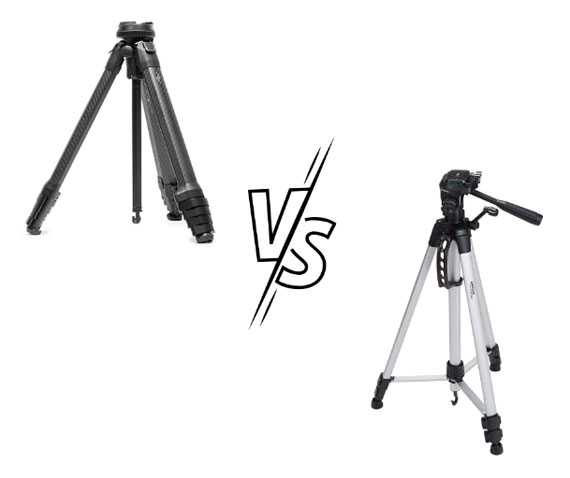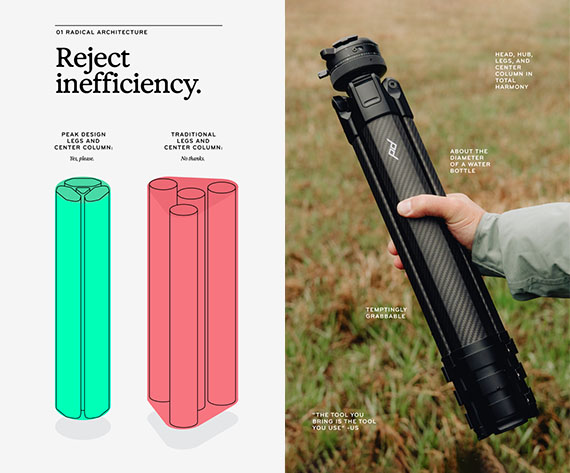What makes them a favorite among landscape and travel photographers
Tripods are essential tools for many genres of photography—whether you’re shooting long exposures, time-lapses, astrophotography, or simply want the sharpest possible landscape images. And when it comes to choosing a tripod material, carbon fiber has carved out a loyal following.
While aluminum tripods remain a solid option for many, carbon fiber models offer some practical advantages that can make a noticeable difference in the field. Below are eight reasons why carbon fiber tripods are often regarded as a top-tier choice by photographers around the world.
Relevant reminder: Kickstarter going on now for the new Peak Design Pro Tripod

1. Lighter Weight, Same Strength
One of the biggest benefits of carbon fiber is its high strength-to-weight ratio. Compared to aluminum tripods of similar stability, carbon fiber versions are often noticeably lighter. This reduced weight becomes particularly valuable when you’re hiking to remote locations, traveling with limited luggage, or carrying your gear for extended periods. Less fatigue often means more time (and energy) spent shooting.
2. Superior Vibration Absorption
Carbon fiber naturally dampens vibrations more effectively than aluminum. This can help reduce micro-movements caused by wind, footsteps, or shutter actuation—especially important during long exposures, macro work, or when using telephoto lenses. The result is often sharper images and more consistent results.
3. Resistant to Weather and Corrosion
Unlike metal, carbon fiber doesn’t corrode when exposed to moisture, salty air, or extreme temperatures. This makes it particularly well-suited for outdoor and coastal photography. While no tripod is invincible, carbon fiber holds up well in tough environments and requires less maintenance over time.
4. Compact and Travel-Friendly Design
Many carbon fiber tripods are designed with portability in mind. Because the material is both light and strong, manufacturers can create slimmer leg profiles without compromising load capacity. This allows for more compact folding designs—ideal for photographers who need to fit their tripod into a backpack or carry-on bag.
5. High Load Capacity
Despite their lighter weight, carbon fiber tripods can typically support heavy camera setups. Full-frame DSLRs, mirrorless cameras with battery grips, and even long telephoto lenses can often be stabilized reliably. This blend of low weight and high load capacity makes carbon fiber a go-to for wildlife and sports photographers as well.
6. Durability and Longevity
Carbon fiber is more resistant to dents and bending compared to aluminum. While it can be more brittle under extreme force, it generally holds up well to regular wear and tear. Many photographers find that a quality carbon fiber tripod remains in service for years—making it a worthwhile long-term investment for those who shoot frequently.
7. Aesthetics and Ergonomics
Though not a performance feature per se, many photographers appreciate the sleek, modern look of carbon fiber. The woven texture and matte finish often feel more refined in the hand. Additionally, many carbon tripods include better locking mechanisms, smoother joints, and upgraded build features, depending on the brand.
8. Better Performance in Challenging Conditions
In cold weather, aluminum tripods can become unpleasant to handle due to their thermal conductivity. Carbon fiber, being a poor conductor of heat, remains more comfortable to grip in freezing temperatures. This can be especially important for photographers working in snow, ice, or early morning conditions.
Final Thoughts
Carbon fiber tripods aren’t necessary for every photographer or every situation. They typically come at a higher cost and may not offer significant advantages if you only shoot occasionally or mostly indoors. But for those who work in varied outdoor conditions, travel frequently, or value weight savings and durability, the benefits can be compelling.
Ultimately, choosing a tripod comes down to your shooting style, budget, and priorities. Understanding the strengths of carbon fiber helps you make a more informed decision—whether you’re comparing models for your next purchase or just curious about why so many professionals lean this way.
New Pro Tripod Just Announced:
With the launch of their new Pro Tripod (now live on Kickstarter), Peak Design has doubled down on the shape-shifting innovation that started it all—this time with a professional audience in mind.
If you’ve ever struggled with tripods that are either too clunky or too flimsy, this new shape-shifted Pro Tripod may be exactly what your kit has been missing.
Kickstarter ending soon: Peak Design Pro Tripod
Like This Article?
Don't Miss The Next One!
Join over 100,000 photographers of all experience levels who receive our free photography tips and articles to stay current:






